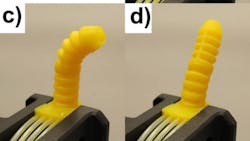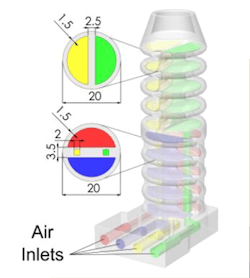The actuator is especially groundbreaking because it is a non-homogenous piece that can be printed using layer-by-layer, digital-mask-projection stereolithography. This method employs a single nozzle and directs visible light at different intensities to cure the photopolymerizable elastomer with different levels of viscosity.
Watch the demonstration of the pneumatic tentacle in the following video.
Pneumatics and Hydrostat Pressure
Stacked chambers arranged in separate columns are filled with fluidic elastomer, so that they will maintain the same volume while experiencing changes in pneumatic pressure. In turn, cross-section and length of the chambers inversely change during pressurization, enabled by the pleated shape of the actuator.
During bending, pressure is increased in one chamber and decreased in another. For the column of chambers that experience decreased pressure, a pleat enables an increase in cross-section and shortens in length. Meanwhile, the pressurized column elongates and cross-section decreases in response to heightened pressure. The internal, incompressible fluid eliminates the need for skeletal structure.
The most developed prototype includes two layers that contain pairs of antagonistic chambers aligned at 90 degrees to achieve four degrees of freedom. Each pair is pressurized by its own pneumatic source, both of which supply opposite signs of pressurization for even bending. Other degrees of motion are possible with this device, such as torsion with the introduction of helically arranged chambers.
About the Author
Leah Scully
Associate Content Producer
Leah Scully is a graduate of The College of New Jersey. She has a BS degree in Biomedical Engineering with a mechanical specialization. Leah is responsible for Hydraulics & Pneumatics’ news items and product galleries.

Leaders relevant to this article:

